User Centric Tracking (2): The next level
The following examples and graphics describe the operation of User Centric Tracking once again in detail. Each individual image – unless stated otherwise – shows a completed visit to the website. Under the images is the information collected by tracking while above them is the information which was additionally written into the database. The most important metrics are also given for each example.
The following abbreviations are used in the graphics:
EID: End device (Cookie ID, in Mapp Intelligence: End device Visitor ID)
CID: Customer ID (in Mapp Intelligence: URM - Custom Visitor ID)
BID: Visitor ID (in Mapp Intelligence: URM - Visitor ID)
Basic information about the User Centric Tracking can be found in the article User Centric Tracking (1): An introduction.
Logic without providing a Customer ID
The user in our examples is Anna. Anna has three different end devices – a smartphone, a tablet and a laptop. She visits an online shopping website with all three end devices, one after the other.
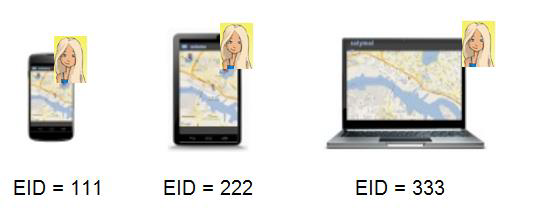
Visitors: 3
Browsers, unique: 3
Anna does not register or log in for any of the visits. This means that no Customer ID is provided to Mapp via which Anna could be identified across all end devices. For this reason, each end device is recorded as an individual visitor. The Visitors metric and the Browsers, unique metric show the same number.
If no Customer ID is provided, the introduction of User Centric Tracking has no effect.
Old logic when providing a Customer ID
Before we come to examples of User Centric Tracking, the old logic should be described once more as a comparison. Until now recognition was possible using the supply of a Customer ID. This was, however, limited.
Anna visited the website using all three end devices. This time, however, she had a Customer ID "A" which she supplied at each visit.
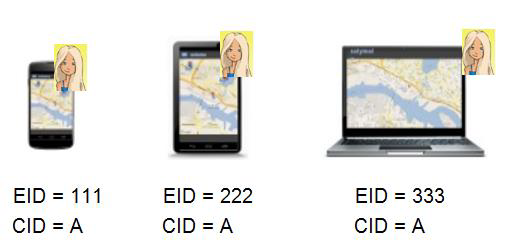
Visitors: 3
Customers, unique: 1 (with 3 Visits)
Browsers, unique: 3
The visitor count (Visitors) remained unaffected by this. By recording the Customer ID, the visits could be grouped in Mapp.
If the Customer ID was not supplied at each visit, however, gaps appeared in the analysis.

Visitors: 2
Customers, unique: 1 (with 2 Visits)
Browsers, unique: 2
In this example, Anna only visited the site using her smartphone and her laptop. Her Customer ID was only supplied for two visits. The third visit was therefore not available for the analysis of the Customer ID.
New logic when providing a Customer ID
These limitations can now be removed thanks to User Centric Tracking.
One user with multiple end devices
As you can see, the following example is identical to the last one. The decisive difference is User Centric Tracking.
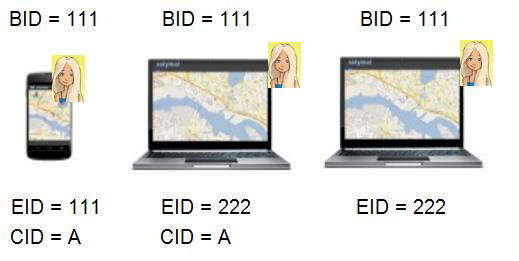
Visitors: 1
Customers, unique: 1 (with 3 Visits)
Browsers, unique: 2
Anna is visiting the website with her smartphone and laptop. She only supplies her Customer ID for two of the visits. Now, however, Anna has received an additional internal Visitor ID which allows her to be recognized. Her smartphone and her Customer ID were tracked for the first time during her first visit. The new Visitor ID therefore receives the same number as the smartphone (Cookie ID). Internally, the smartphone, Customer ID and Visitor ID are linked in order to permit subsequent recognition.
During her second visit the laptop is unknown, but Anna can still be identified using her Customer ID. The visit is therefore allocated to her Visitor ID. The laptop is also internally linked to her Visitor ID.
No Customer ID is supplied for the third visit. This time, however, Anna can be identified thanks to the laptop she is using. This visit is therefore also allocated to her Visitor ID.
The Visitors metric is based on the Visitor ID. 1 Visitor is therefore counted. Using the old logic the total count was 2 Visitors. Furthermore, thanks to the Visitor ID the Customer ID can now be allocated to all 3 visits as opposed to only 2 using the old logic. What is important is that the Customer ID must be supplied during the first visit using a new additional end device (in this example the laptop).
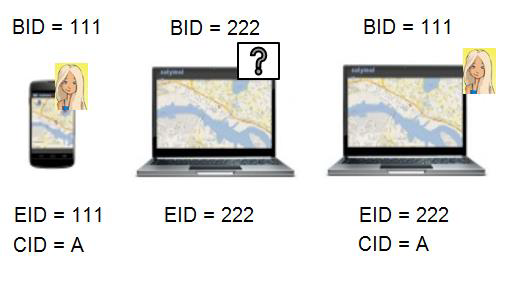
Visitors: 2
Customers, unique: 1 (with 2 Visits)
Browsers, unique: 2
In this example, no Customer ID is supplied during the second visit. The laptop is, however, still unknown during this visit. It can therefore not be allocated to Anna and a new Visitor ID is generated internally.
The allocation of a visit to a Visitor ID always takes place at the end of a visit and cannot be modified retroactively. The link between Anna's Visitor ID "111" and her laptop is therefore only effective beginning from the third visit.
One exception to this rule is the missing supply of a Customer ID during the first visit in general.

Visitors: 1
Customers, unique: 1 (with 2 Visits)
Browsers, unique: 1
Anna had already visited the website once using her laptop before registering and receiving a Customer ID. Since the Visitor ID does not need to be modified retroactively and only needs to be linked to the Customer ID, both visits are allocated to Anna.
Multiple users with a single end device
Anna has a boyfriend – Björn. Björn is also interested in the products of the online shop and uses Anna's laptop.
Björn has his own Customer ID "B". Using this Customer ID, he can be uniquely identified during his visit even though he is using Anna's laptop.
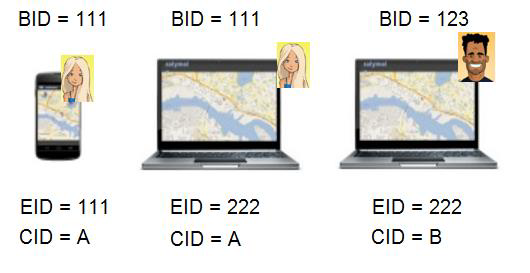
Visitors: 2 (with 3 Visits)
Customers, unique: 2 (with 3 Visits)
Browsers, unique: 2
The third visit is therefore allocated to him and not to Anna. For his Visitor ID, a number is generated which is independent of that of the Cookie ID for the laptop.
If the laptop is then used for another visit during which no Customer ID is supplied, the visit is always allocated to the most recent visitor identified by Customer ID – in this case Björn.
But what happens if Anna and Björn visit the website one immediately after the other and Björn's Customer ID is supplied before Anna's visit is concluded (after 30 minutes of inactivity)? A visit can always only be allocated to a single visitor.

Visitors: 2 (with 3 Visits)
Customers, unique: 2 (with 3 Visits)
Browsers, unique: 1
As soon as Björn's Customer ID is supplied, Mapp recognizes that he is a new visitor and internally divides the visit into two visits (marked by the dashed line). One is allocated to Anna and the other to Björn.
Synoptical table
